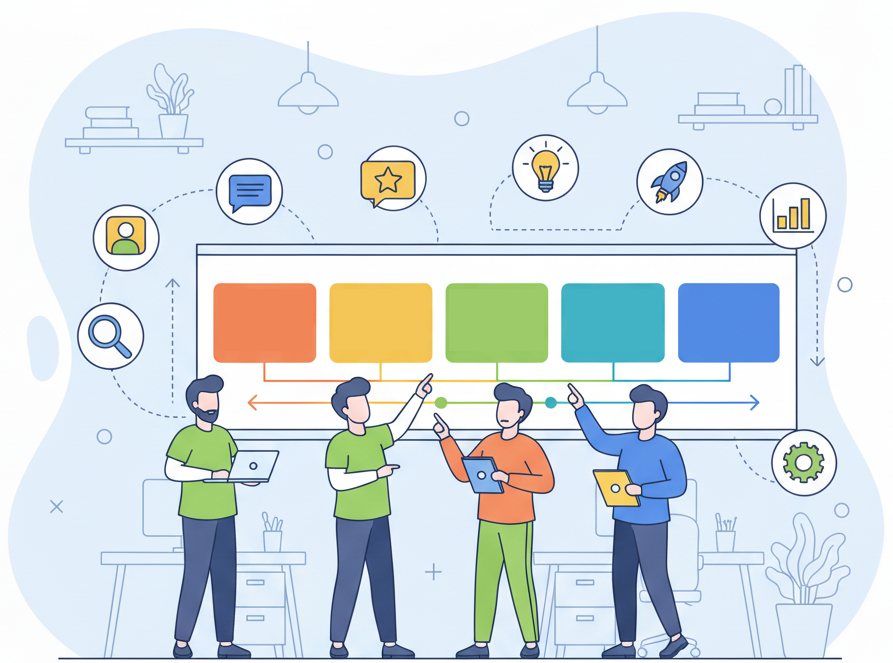Now Reading: Agile Affinity Mapping: SaaS Startup Case Study
-
01
Agile Affinity Mapping: SaaS Startup Case Study
Agile Affinity Mapping: SaaS Startup Case Study
From Overwhelmed to Organized: How a SaaS Startup Defined its Roadmap
A fast-growing SaaS startup used the planner to analyze hundreds of pieces of user feedback, transforming a chaotic list of requests into a clear, data-driven feature roadmap that aligned the entire company.

The Challenge
The product team was drowning in feature requests from various channels: support tickets, sales calls, and in-app feedback. Without a structured process, roadmap planning meetings were dominated by opinion and the “loudest voice in the room.” This led to developer frustration over shifting priorities and a sales team that couldn’t confidently communicate future value to prospects.
The Process: From Chaos to Clarity
Before the Planner: Gathering Raw Data
Before using the planner, the Head of Product spent a full week consolidating feedback. This involved exporting over 300 individual comments from Intercom, Zendesk, and a Typeform survey into a massive spreadsheet. Each piece of feedback was manually tagged with its source and user segment to preserve context for the upcoming analysis.
Step 1: Prepare for Affinity Mapping
Inside the Affinity Mapping Planner, they used the “Prepare” step to define a crystal-clear goal: “Identify and prioritize the top 3 feature themes for the next quarter’s roadmap.” They knew a diverse set of viewpoints was crucial, so they invited the Head of Product, a lead engineer, and a customer success manager to the session.
Step 2: Conduct the Mapping Session
For the “Conduct” step, they planned a 90-minute remote workshop. The generated plan detailed using a Miro board where each piece of feedback from the spreadsheet would be pre-populated on a digital sticky note. The first 30 minutes of the agenda were strictly allocated for silent, independent grouping of these notes to avoid influential voices biasing the initial sorting.
Step 3: Analyze and Prioritize Groups
In the “Analyze and Prioritize” step, they selected an Impact-Effort Matrix as their prioritization framework. The plan was to discuss each theme that emerged from the grouping exercise and have the team collectively vote on its perceived user impact and required development effort. This method was chosen to visually highlight the “quick wins” and high-value strategic features.
Step 4: Implement and Monitor Actions
To ensure outcomes led to action, the “Implement and Monitor” step was crucial. The plan was to immediately convert the prioritized themes into Epics in Jira, assigning them to the next development cycle. They also defined a success metric: “Reduce support tickets related to missing features by 15% within two months of launch.”
After the Planner: Running the Workshop
The generated PDF report became the facilitator’s single source of truth for the Miro workshop. It provided a step-by-step agenda that kept the team focused and productive. Following the plan, the team successfully grouped the 300+ notes into 12 distinct themes. The subsequent Impact-Effort matrix exercise was incredibly effective, clearly highlighting ‘Improved User Permission Controls’ and ‘Third-Party Calendar Integration’ as high-impact, medium-effort wins. These became the core of the next quarter’s roadmap.
The Results
The planner transformed a chaotic, subjective process into a structured, efficient, and collaborative system. The team moved from endless debates to objective, data-backed decisions, building company-wide confidence in the product direction. The Head of Product noted, “The clarity was immediate. We went from circular debates to a clear, defensible plan in one afternoon.”
- Delivered a clear, prioritized product roadmap that aligned the product, engineering, and sales teams.
- Reduced time spent in contentious roadmap planning meetings by over 50%.
- Shipped two highly requested features that led to a 10% increase in user engagement and were instrumental in closing three major enterprise deals.
- Established a repeatable, scalable process for analyzing user feedback for all future planning cycles.

